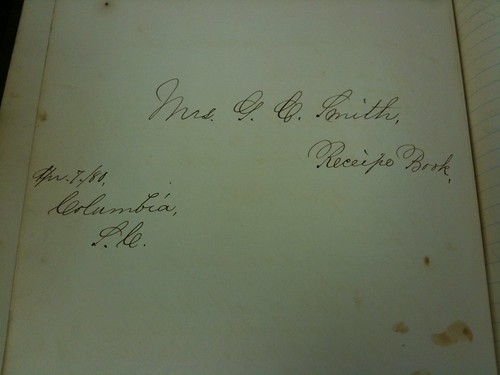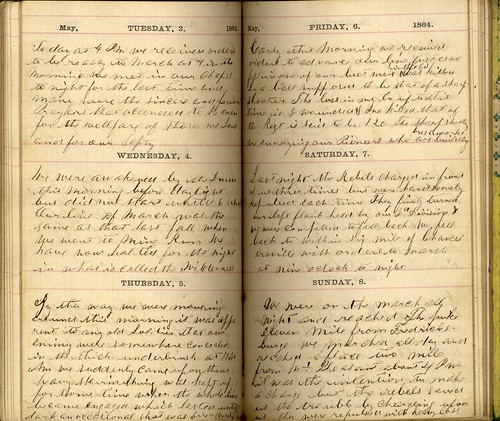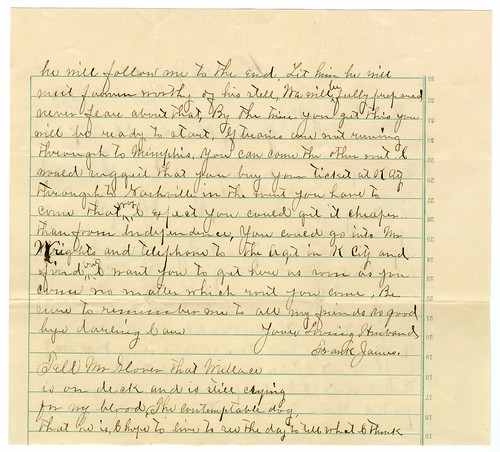8.29.2011
Mrs. Smith's Best Ginger Snap Recipe (from 1880)
Ms. Manami Matsuoka, Wofford's expert on Japan


8.26.2011
A Private's Wilderness
-Private Jesse Easton Bump, May 3, 1864
The Littlejohn Collection at Wofford College is home to the journal of Private Jesse Easton Bump, a Union soldier during the American Civil War. Bump was a soldier in the 119th Regiment, or the Pennsylvania “Gray Reserves.” He wrote a short entry almost everyday between September 1863 and August 1864. The entries below describe Bump’s experience during the Battle of the Wilderness which took place near Orange County, Virginia from May 5 to May 7.
The Battle of the Wilderness was the beginning of Lieutenant General Ulysses S. Grant’s Overland Campaign. The objective of the battle was to gain possession of General Robert E. Lee’s Army of Northern Virginia. The Union and Confederate armies had spent the winter in close proximity; the Confederates were camped on one side of the Rapidan River at Mine Run and the Union army on the other side of the river near Culpeper.1Private Bump and the rest of the VI Corps left their winter camp and crossed the Rapidan River on May 4, 1864. He wrote in his journal,
We were awakened by the drum this morning before daylight but did not start until 6 o clock[.] Our line of march was the same as that last fall when we went to Mine Run[.] We have now halted for the night in what is called the Wilderness[.]
In order to avoid the strongly fortified Confederate camp at Mine Run, Grant decided the Army of the Potomac would have to fight in the wilderness surrounding the Rapidan River. The Wilderness was riddled with gullies and tangled underbrush. An individual would find the terrain difficult to move through, yet Grant ordered an entire army to march through it. Because of the wild landscape heavy artillery and cavalry (which were among Grant’s main advantages against the Confederates) could not be used effectively.2
By the way we were moveing [sic] around this morning it was apparent to any old Soldier that our enimy [sic] were somewhere concealed in the thick underbrush[.] at 11,30 Am we suddenly came upon them[.] heavy skirmishing was kept up for some time when the whole line became engaged which lasted until dark[.] an occasional shot was fired during the night[.]
By late morning on May 5, Grant sent VI Corps to hold the strategic Orange Plank and Brock crossroads at any cost until reinforcements could arrive.5 The battle was unlike any the soldiers had seen so far. The wild landscape made fighting more chaotic than usual; lines between divisions blurred among the tall trees and the dry forest caught fire on many occasions. Bump’s journal entry on May 6 details the number of men lost in the Wilderness:
Early this morning we received orders to advance our line first[.] as we fell in one of our best men (in the Co) was killed by a ball supposed to be that of a sharp shooter[.] The loss in my Camp to this time is 8 wounded one killed[.] that of the Regt is said to be 120[.] The sharp shooters are annoying our Pioneers who are building brestworks [sic]
By the end of the battle, about 15,000 Union soldiers were killed, wounded, or missing. The Confederates lost about 11,400.6
Neither side was able to gain a permanent advantage by the second day of fighting because everyone had trouble maneuvering and maintaining order.7 In a last attempt, Ewell ordered a surprise attack on VI Corps on May 6, but the Confederates quickly became disorganized and struggled to gain their objective. Bump recounted these events the next morning in his journal:
Last night the Rebels charged in front of us three times but were handsomely repulsed each time[.] They finally turned our left flank held by our 2d Division & we were compelled to fall back we fell back to within six mile of Chancelersville [sic] with orders to march at nine o clock to night[.]
As Bump states in his journal, Grant ordered the soldiers to prepare for a night march on May 7. The Army of the Potomac was to move to Spotsylvania,Virginia in order to gain an advantage: the open fields surrounding Spotsylvania would be better for fighting and, if held, would be important in securing Richmond, the Confederate capitol. Already exhausted from two days of hard fighting, the army marched all night to Spotsylvania where fighting continued.
- Hannah Jarrett '12
1 Joseph P. Cullen, “Battle of the Wilderness,” Wilderness and Spotsylvania, Harrisburg: Eastern Acorn Press, 1985, p. 4.
2 ibid.
3Cullen, p. 5.
4 Noah Andre Trudeau, “Battle of the Wilderness.”
5 Cullen, p. 9.
6 Cullen, p. 15.
7 ibid.
8.24.2011
Google Doodle Honors Argentine Author Jorge Luis Borges | PCWorld
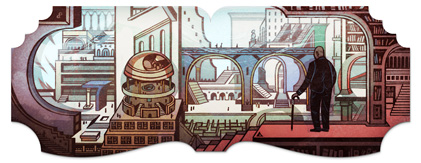
The latest mysterious Google doodle honors what would have been Argentine author Jorge Luis Borges' 112th birthday. Aside from being a pioneer in the genre of magical realism, Borges also imagined some of the foundational concepts of the Internet, such as "hypertext," long before the dawning of the digital age.
8.18.2011
Old Bailey Trials Are Tabulated for Scholars Online - NYTimes.com
“The Old Bailey Online project has done a great service in making those sources widely (and costlessly) available,” Mr. Langbein [of Yale University] wrote in an e-mail. But he complained that the claims about data mining have “a breathless quality: ‘you can expect big things from us,’ but as yet it’s all method and no results.” He said that the new findings belittle the work of a generation of scholars who focused on the 18th century as the turning point in the evolution of the criminal justice system.
Mr. Turkel, who developed some of the digital tools, said that data mining reveals unexpected trends and connections that no one would have thought to look for before. Previous scholars “tended to cherry-pick anecdotes without having a sense that it was possible to measure all of that text and treat the whole archive as a single unit,” he said.
8.11.2011
The Trial and Acquittal of Frank James
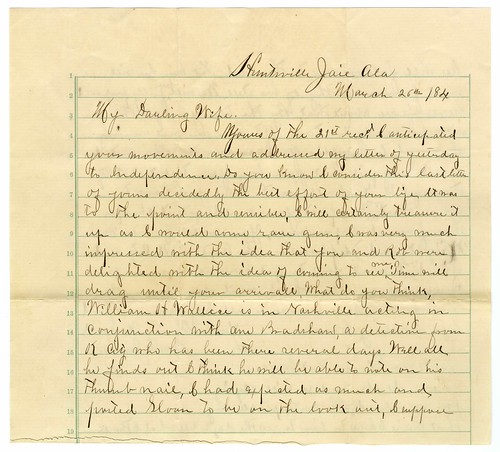
[TRANSCRIPTION:]
[recto]
Yours of the 21st rec’d I anticipated your movements and addressed my letter of yesterday to Independence. Do you know I consider this last letter of yours decidedly the best effort of your life. It was to the point and remember, I will certainly treasure it up as I would some rare gem, I was very much impressed with the idea that you and Rob were delighted with the idea of coming to see me. Time will drag until your arrival, what do you think William H. Wallace is in Nashville there acting in conjunction with one Bradshaw, a detective from Kansas City who has been there several days. Well, all he finds out I think he will be able to note on his thumbnail, I had expected as much and posted Glover to be on the lookout, I suppose
Your loving husband
Frank James
Tell Mr. Glover that Wallace
is on deck and is still crying
for my blood, The contemptible dog,
and that he is, I hope to live to see the day to tell what I think.
A notorious outlaw and member of the James-Younger gang, Frank James had been in prison since October 4, 1882, when he voluntarily surrendered to Missouri Governor Thomas T. Crittenden. James handed Crittenden his holster and said “Governor Crittenden, I want to hand over to you that which no living man except myself has been permitted to touch since 1861, and to say that I am your prisoner.”1 His surrender occurred six months after his brother and partner in crime, Jesse James, was assassinated by Robert Ford.
After his arrest, Frank James was moved to a jail cell in Independence, MO. His reception and treatment was hardly that of a dangerous criminal. He was allowed to wave at crowds from the back of the train that transported him. A reception dinner was held for him once he arrived in Independence. Supposedly, bankers offered to post a $100,000 bail for his release. In jail, Frank was allowed books, a comfortable chair, visitors, and whatever else he requested. He felt confident that he would not be convicted since the crimes he was accused of were committed years before. In the event that he was convicted, James was certain he would pardoned by the Governor. And in a bizarre turn of events, Frank James managed to be acquitted or pardoned for every crime he was accused of committing.2
While James was being held in Independence, he was charged with the the murder of Chicago detective Whicher (1874), the Independence bank robbery and murder of John Sheets (1869), the Blue Cut train robbery (1881), and the Winston train robbery and the murder of conductor William Westfall and passenger Frank McMillan (1881). James was acquitted on all accounts because the jury was not persuaded by the testimony of the prosecution’s primary witness Dick Liddell (also spelled “Liddil”), a former member of the James-Younger gang. The eloquent closing statements of John F. Phillips and Charles P. Johnson succeeded in convincing the jury that there was not enough evidence linking James to the crimes. By this point, James had won the sympathy of most Missourians due to his Confederate loyalties and his Robin Hood-like desire to avenge his family and former members of the Quantrill guerrillas for the crimes committed against them during and after the Civil War.3
During the war, James was a member of the Quantrill guerrillas, a group of pro-Confederate bushwhackers in Missouri. James’s involvement in the group had a significant impact on his criminal career. Many of James’s later crimes were in response to the way his friends and family were treated during the war. On one particular occasion, Unionists questioned Zerelda Samuel, James’ mother, about her son’s whereabouts and the location of the Quantrill guerrillas. They pushed her around, despite the fact that she was pregnant at the time. When she refused to give up any information, they tortured Dr. Reuben Samuel (James’s step-father) by hoisting him four times from the branch of a tree. He also refused to give away any information about his step-son’s whereabouts. Desperate for information, the Unionists chased and beat Jesse, Frank’s younger brother. In the end, Zerelda and Reuben were put in jail and Jesse’s hatred for Unionists increased, leading him to join his brother as a member of the Quantrill guerrillas.4
After the war, Frank and Jesse were harassed by members of the community because they were members of the Quantrill guerrillas. The Pinkerton Detective Agency was known to be involved in hunting the brothers throughout their criminal career. Allegedly, the Pinkertons were involved in bombing the James-Samuel house one night. The family heard a noise and went to the kitchen to discover that the west side of the house was on fire. Reuben saw a bomb and tried to shovel it into the fireplace. He was too late. The bomb went off, killing Archie James and injuring Zerelda (she lost her right arm). The continuous harassment of their family and friends can be seen as one of the leading motivations behind Frank and Jesse’s criminal behavior.5
The James brothers’ motivation for the Independence Bank robbery and murder of John Sheets was to avenge the murder of their friend Bloody Bill Anderson. Supposedly, the brothers had mistaken Sheets for Major S. P. Cox, whose troops had ended Bloody Bill Anderson’s career in 1864. Others believed that the robbers thought Sheets had somehow been involved in killing Anderson.6 As for the Winston train robbery and murder of William Westfall, Jesse James believed Westfall had been aboard the train that carried the Pinkertons to the bombing of the James-Samuel house. Similarly, the criminals announced that their attack on the train at Blue Cut was in response to Chicago and Alton Railroad’s participation in the reward offer for their capture.
After James was acquitted and released in Independence, he was immediately arrested again; this time for the Muscle Shoals robbery in Alabama. He was moved to a jail in Huntsville, AL, and on April 17, 1884, Frank was tried. Like the trail in Independence, Liddell failed to convince the jury that his testimony was reliable. Furthermore, the defense called to witness several people who claimed to have seen James in Nashville at the time of the robbery, which supported James’s alibi that he had been staying in Nashville under the name B.J. Woodson when the crime took place in Alabama. He was again found not guilty.
Upon his release, James was immediately arrested for the Rocky Cut robbery of July 7, 1876, but Governor Crittenden pardoned him. For good.
James spent the next thirty years doing various jobs; he was a shoe salesman, a ticket-taker at a theater, and a telegraph operator. Right before his death, he supported himself and his family by giving tours of the James farm in Missouri for 25 cents. He died at age 71, leaving behind his wife and son.
2 Michael J. Cronan, “Trial of the Century!: The Acquittal of Frank James,” Missouri Historical Review Vol. 1, Issue 2, January 1997, p. 134.
3 Cronan, p. 133-153.
4 Brant, p. 26-33.
5 Brant, p. 133-136.
6 William A. Settle, Jesse James was His Name: or, Fact and Fiction Concerning the Careers of the Notorious James Brothers of Missouri, Lincoln: University of Nebraska Press, 1977, p. 40.
8.05.2011
A new app about a King's book; A book about a King, his book

Written with a touch of the irreverent, Majestie is a shared biography: that of the first Stuart King of England (James I) and the Bible that goes by his name. It is part tabloid, part history lesson, part speculation; but it’s all James.

